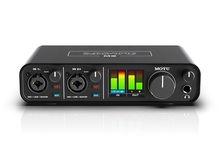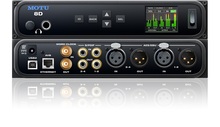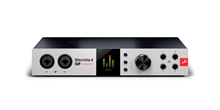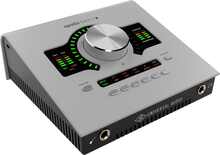RME Babyface Pro FS
Artikkelnummer 106316524-Channel 192 kHz bus-powered USB interface
På weblager. Lev.tid ca 5-10 dager
Betal direkte, faktura eller delbetaling - Lagre kort og bankkonto - Enkelt og trygt - Klarna kjøperbeskyttelse
The new RME Babyface Pro FS is a completely refreshed 24-channel, 192 kHz, bus-powered USB audio interface of the model introduced four years ago, and which demonstrated RME’s absolute commitment to superior craftsmanship, not only in audio circuits and driver development, but also in mechanics. Created with the highest precision from a block of aluminum, this high-end portable interface incorporated newly designed analog and digital circuits. Its innovative energy saving technologies provided supreme fidelity with no compromises in level, noise or distortion.
In the new Babyface Pro FS even more improvements were implemented, including a +19/+4 dBu switch on the bottom that adds a direct way to reduce the output level, thus improving SNR for sensitive active monitors, avoiding distortion/overload, and helping to keep TotalMix FX faders near 0dB instead of high attenuations. The full SteadyClock FS circuit, as in the ADI-2 Pro FS, allows for lowest jitter and highest jitter immunity, while the 3.5 mm TRS phones output power rises from 70 mW to 90 mW. THD of both phones outputs is improved by up to 10 dB using the same output op-amps as the ADI-2 Pro. Output impedance of the 3.5 mm TRS output was also lowered from 2 Ohms to 0.1 Ohms.
New features:
- +19 / +4 dBu switch on the bottom adds a direct way to reduce the output level, thus improves SNR for sensitive active monitors, avoids distortion / overload, and helps to keep TotalMix FX faders near 0 dB instead of high attenuations.
- Full SteadyClock FS circuit as in the ADI-2 Pro FS for lowest jitter and highest jitter immunity.
- 3.5 mm TRS phones output power rises from 70 mW to 90 mW. THD of both phones outputs improved by up to 10 dB. Uses same output op-amps as ADI-2 Pro now. Output impedance of 3.5 mm TRS lowered from 2 Ohms to 0.1 Ohms.
- Mic inputs SNR improved from 112.2 dB to 113.7 dB, TRS Line inputs SNR improved from 114 dB to 116.3 dB (120 dBA). THD Line inputs improved by 8 dB.
- 6 samples less latency on the AD side by new ADC (5 samples AD, 7 samples DA. It won't get quicker...).
- All the above improvements were achieved without raising the units power consumption.
- K-slot for theft protec
































